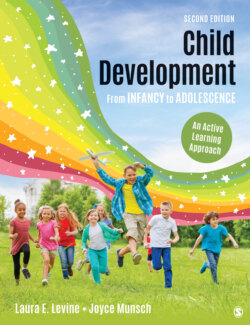Читать книгу Child Development From Infancy to Adolescence - Laura E. Levine - Страница 251
На сайте Литреса книга снята с продажи.
Becoming a Mother
ОглавлениеIn a society that idealizes mothers as being totally self-sacrificing, all-giving nurturers, women who struggle with the normal array of mixed feelings may have an added burden of guilt that they are not living up to this ideal if they are not ecstatic following the birth of their baby (Zamosky, 2011). It is a common misconception that after a baby is born, a new mother automatically follows her instincts and knows just what to do (Redshaw & Martin, 2011). In fact, many first-time mothers around the world must learn to be comfortable with breastfeeding, changing diapers, and soothing a crying baby. The way they were mothered as a child provides an unconscious model for most women of what a mother should be like, and new mothers also frequently turn to their own mothers, relatives, child care professionals, and books or websites on child care for support and advice. However, when a woman receives conflicting advice from different sources, it adds to her stress rather than relieving it (Hogan, 2017).
T/F #9
When a woman gives birth she instinctively knows what to do to care for her new baby. False
New mothers get some help from their biology. A surge of sex steroid hormones, progesterone and estrogen, changes the structure of the new mother’s brain in the area that helps us think about what is going on in someone else’s mind (Caruso, 2016). These structural changes are associated with the woman’s feeling of attachment to her infant and persist for at least 2 years. You will learn more about the factors that influence the formation of an attachment bond between parents and infants in Chapter 7. Nurturing behavior gets a boost from hormones such as oxytocin and prolactin, which are at elevated levels in expectant and new mothers (Kohlhoff et al., 2017; Zhang, Su et al., 2017).
The rapid hormonal changes that follow childbirth, along with other stresses new mothers experience, can result in the anxiety, irritability, sadness, and restlessness that we associate with the “baby blues” (U.S. National Library of Medicine, 2016d). These feelings usually go away without treatment within 2 weeks of the birth. A little time, together with some rest and help with caring for the newborn, are usually enough to alleviate the symptoms. When symptoms last longer or are more severe, the mother may be suffering from the mood disorder depression with peripartum onset. The peripartum period includes the last month of pregnancy and the first couple of months after birth. For half of the women who experience severe depression, the symptoms begin before the baby is born. Symptoms can include sadness, loss of interest in things that had been pleasurable, lack of energy, trouble concentrating, feelings of guilt or worthlessness, and severe anxiety or even panic attacks (APA, 2013). When symptoms are severe enough to interfere with the woman’s ability to function, she should consult her doctor because effective treatments are available. The most common approaches are antidepressant medications and counseling or therapy (Mayo Clinic, 2015a).
Depression with peripartum onset: A major depression that occurs in the last month of pregnancy or the first couple of months after birth.
Just as there are cultural differences in the birth process, there are differences in what happens after birth. To continue our cross-cultural comparisons from earlier in the chapter, the new Ifaluk mother will never be left alone in the first 10 days following the birth of her baby, and she is not expected to do any work for the first 3 months of the baby’s life. Other women, usually relatives, cook and take care of household tasks while the mother rests (Le, 2000). In the Netherlands, a nurse visits the home for at least 7 days after the birth to provide medical care for the mother and infant, but also to cook, clean, and provide parenting information, with all services covered by insurance (Schalken, n.d.). Women in rural Nepal who give birth in a traditional goth remain there for 20 to 22 days after the birth and do not enter the house for 30 days after the birth (Kaphle et al., 2013). In many Asian, Middle Eastern, Latin, and indigenous cultures, the month or so following the birth of a baby is considered a crucial time for the new mother to recover. In this process, she has support from a female-oriented cultural network and cultural traditions that celebrate the birth as a new beginning for the woman and her family (Chang, 2011).
By contrast, women in Western society receive little recognition from society that their new role is valued, and they may have only limited support. Visitors are more interested in the newborn than the new mother, and women with young infants often feel uncomfortable or unwelcome in public places such as restaurants or coffee shops. Consequently, new mothers can feel a profound sense of isolation (Kendall-Tackett, 2014). Many also feel pressure (or financial need) to quickly return to work and may be torn between this need and their desire to devote themselves to caring for their infant. Later in this chapter, we discuss paid parental leave for both mothers and fathers.
Description
New mothers in Micronesia and the United States. A new Ifaluk mother receives support from others in her community who help care for her and her child as she recovers from childbirth. New mothers in the United States, by contrast, may feel unwelcome and unwanted in public places such as restaurants. When a restaurant posted a sign similar to the one on the right, it experienced a 40% increase in reservations after their policy received news coverage.
Philip Game / Alamy Stock Photo
